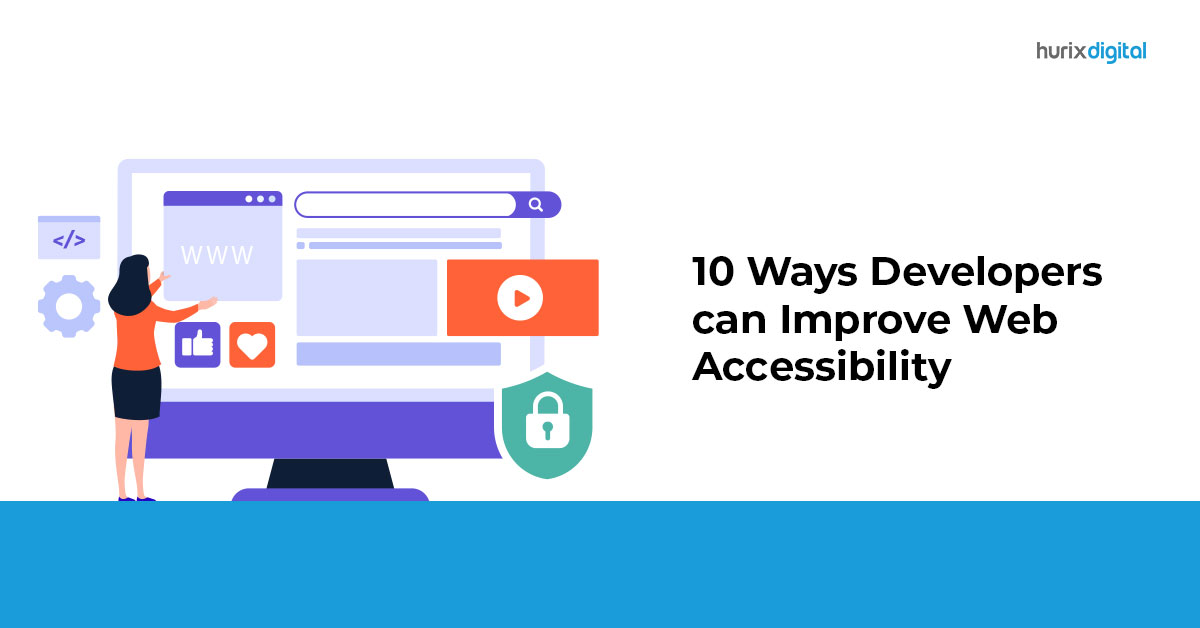10 Ways Developers can Improve Web Accessibility
Creating accessible websites is essential to ensure equal access and inclusivity for all users, regardless of their abilities. For new developers, understanding and implementing web accessibility can be a daunting task. However, with the right knowledge and practices, you can make a significant impact on improving web accessibility. Accessibility for websites is not beneficial for the users, but it greatly enhances the organization’s revenue.
In this blog, we will provide in-depth information and recommendations for new developers to create accessible websites and enhance web accessibility. By following this accessibility developer guide and incorporating accessibility guidelines for web developers, you can build inclusive websites that leave no one behind.
Table of Contents:
- Learn Web Accessibility Standards
- Use Semantic HTML
- Provide Alternative Text for Images
- Ensure Keyboard Accessibility
- Use ARIA Roles and Attributes
- Design for Color Contrast
- Make Forms Accessible
- Caption Videos and Provide Transcripts
- Test with Assistive Technologies
- Regularly Update and Maintain Accessibility
- Conclusion
Learn Web Accessibility Standards
Start by gaining a solid understanding of web accessibility and its importance. Familiarize yourself with accessibility guidelines such as 508 accessibility compliance, ADA-compliant websites, and the Web Content Accessibility Guidelines (WCAG). These standards provide a framework for ensuring accessibility and creating a positive user experience.
Use Semantic HTML
Use semantic HTML elements to provide a clear and meaningful structure to your web pages. Properly structured headings, lists, and navigation menus help screen readers and assistive technologies understand the content and facilitate easy navigation for users with disabilities.
Provide Alternative Text for Images
Include descriptive alternative text (alt text) for images. Alt text provides a textual description of the image, allowing visually impaired users to understand and engage with the visual elements on your website.
Also Read: The Business Benefits of Accessibility for Publishers
Ensure Keyboard Accessibility
Test your website’s functionality using only a keyboard. Ensure that all interactive elements, such as links, buttons, and form inputs, can be easily accessed and operated without the need for a mouse. Pay attention to focus indicators to ensure clear visibility and proper navigation flow.
Use ARIA Roles and Attributes
Accessible Rich Internet Applications (ARIA) roles and attributes enhance the accessibility of complex web components. Use ARIA roles and attributes to provide additional information to assistive technologies about the behavior, structure, and state of interactive elements.
Design for Color Contrast
Consider the contrast between text and background colors to ensure readability for users with visual impairments. Aim for a sufficient level of contrast to make your content accessible to all users, including those with low vision.
Make Forms Accessible
Ensure that form elements are accessible to all users. Provide clear labels for form inputs, use appropriate input types, and provide informative error messages. Use proper validation techniques and consider using additional cues, such as ARIA attributes, to assist users in completing and submitting forms correctly.
Caption Videos and Provide Transcripts
Caption videos to make them accessible to individuals with hearing impairments. Use closed captions and provide transcripts as textual alternatives for users who prefer or require them. These measures also benefit non-native speakers, individuals in noisy environments, and those who prefer reading over watching. By incorporating captions and transcripts, organizations can enhance their video content’s reach, engagement, and usability while prioritizing accessibility for all users.
Test with Assistive Technologies
Utilize assistive technologies such as screen readers, magnifiers, and keyboard-only navigation to test your website’s accessibility. Seek feedback from individuals with disabilities to gain valuable insights and ensure that your website meets their needs. By using screen readers, keyboard-only navigation, and other assistive tools, developers can identify and address accessibility issues, ensuring a seamless user experience for all users. Incorporating assistive technology testing in the development process helps create inclusive digital experiences that meet accessibility standards.
Regularly Update and Maintain Accessibility
Web accessibility is an ongoing process. As you develop and update your website, continue to prioritize accessibility. Stay updated with new accessibility standards and best practices. Regularly review and audit your website for accessibility issues and address any identified barriers promptly.
Also Read: How to Make Accessible Courses for Higher Education Students
Conclusion
By following this accessibility developer guide and incorporating accessibility guidelines for web developers, you can play a crucial role in improving web accessibility. Creating accessible websites ensures inclusivity, enhances user experience, and expands your audience reach. Embrace accessibility as a core principle of web development and contribute to building an inclusive digital landscape. Hurix Digital is one such organization that understands the importance of accessibility and strives for providing quality accessibility solutions. Get in touch with Hurix Digital to start your accessibility journey today.









